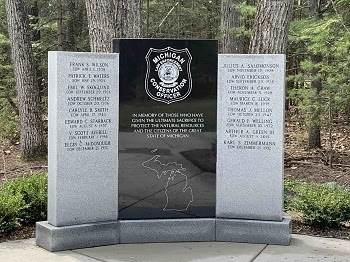Being Safe During Deer Hunting Season
By Glen Wunderlich
With the Nov. 15 firearm deer approaching, Michigan Department of Natural Resources conservation officers encourage hunters to brush up on safety tips and hunting regulations to ensure a safe, enjoyable experience.
The following general safety tips will help to insure that we hunters continue the trend to safer hunting:
o Treat every firearm as if it is loaded. That also means that if someone is offering to show you his firearm and presents it to you, ask him to open the action to verify it’s clear. If you are the one presenting the firearm, make it your automatic policy to show it’s clear before someone else touches it.
o Keep your finger away from the trigger and outside the trigger guard until you are ready to fire. By following these instructions, others can be sure that the firearm cannot inadvertently discharge.
o Keep the safety on until you are ready to fire. A person’s hidden rationale for not using the safety may result from not becoming familiar with the firearm. As a result, he may leave the gun ready to fire, so as not to forget later. Or, maybe he forgot to check after loading and chambering a round. Both are bad excuses. Practice with the empty gun you will use until the process of taking the gun off “safe” is natural. Another reason people will intentionally leave a gun in the “fire” position is because some safety mechanisms make an audible click, if operated quickly, and could spook game. You should practice operating the safety slowly, so as to minimize any related sound.
o Always point the muzzle in a safe direction. It doesn’t matter if you know the gun is empty; make it a habit! Also, point out any unsafe handling to others, if they get careless.
o Be certain of your target, and what’s beyond it, before firing. To be certain of your target, get in the habit of carrying binoculars. A good harness can make them accessible quickly and some will guard against the elements. You don’t want to get in the habit of using your scope to identify objects – especially what may turn out to be another hunter!
o Know the identifying features of the game you hunt. If you cannot verify that what you are looking at is what you want to kill, hold your fire. Otherwise, you’re setting yourself up to be the person that tries to explain away your negligence.
o Unload the firearm before running, climbing a fence or tree, or jumping a ditch.
o Wear a safety harness when hunting from an elevated platform. Use a haul line to bring the unloaded firearm up and down the raised platform.
o Always wear a hat, cap, vest or jacket of hunter orange, visible from all sides, with a minimum of 50 percent hunter orange during daylight hunting hours, even if hunting on private land. The law also applies to archery hunters during firearm season.
o Always let someone know where you are hunting and when you plan to return. This information helps conservation officers and others locate you, if you become injured or lost.
o Carry a cell phone into the woods. Not only does it let you call for help, if necessary, but newer phones emit a signal that can help rescuers locate you. Double check to make sure it’s in quiet mode, though.
o Program the DNR’s Report All Poaching (RAP) line (800-292-7800) in your phone contacts so you can alert conservation officers to any natural resources violations you may witness.






